Ottawa vs Laotian Community Comparison
COMPARE
Ottawa
Laotian
Social Comparison
Social Comparison
Ottawa
Laotians
3,097
SOCIAL INDEX
28.5/ 100
SOCIAL RATING
233rd/ 347
SOCIAL RANK
8,033
SOCIAL INDEX
77.8/ 100
SOCIAL RATING
91st/ 347
SOCIAL RANK
Laotian Integration in Ottawa Communities
The statistical analysis conducted on geographies consisting of 36,991,951 people shows a mild negative correlation between the proportion of Laotians within Ottawa communities in the United States with a correlation coefficient (R) of -0.323. On average, for every 1% (one percent) increase in Ottawa within a typical geography, there is a decrease of 0.044% in Laotians. To illustrate, in a geography comprising of 100,000 individuals, a rise of 1,000 Ottawa corresponds to a decrease of 44.3 Laotians.
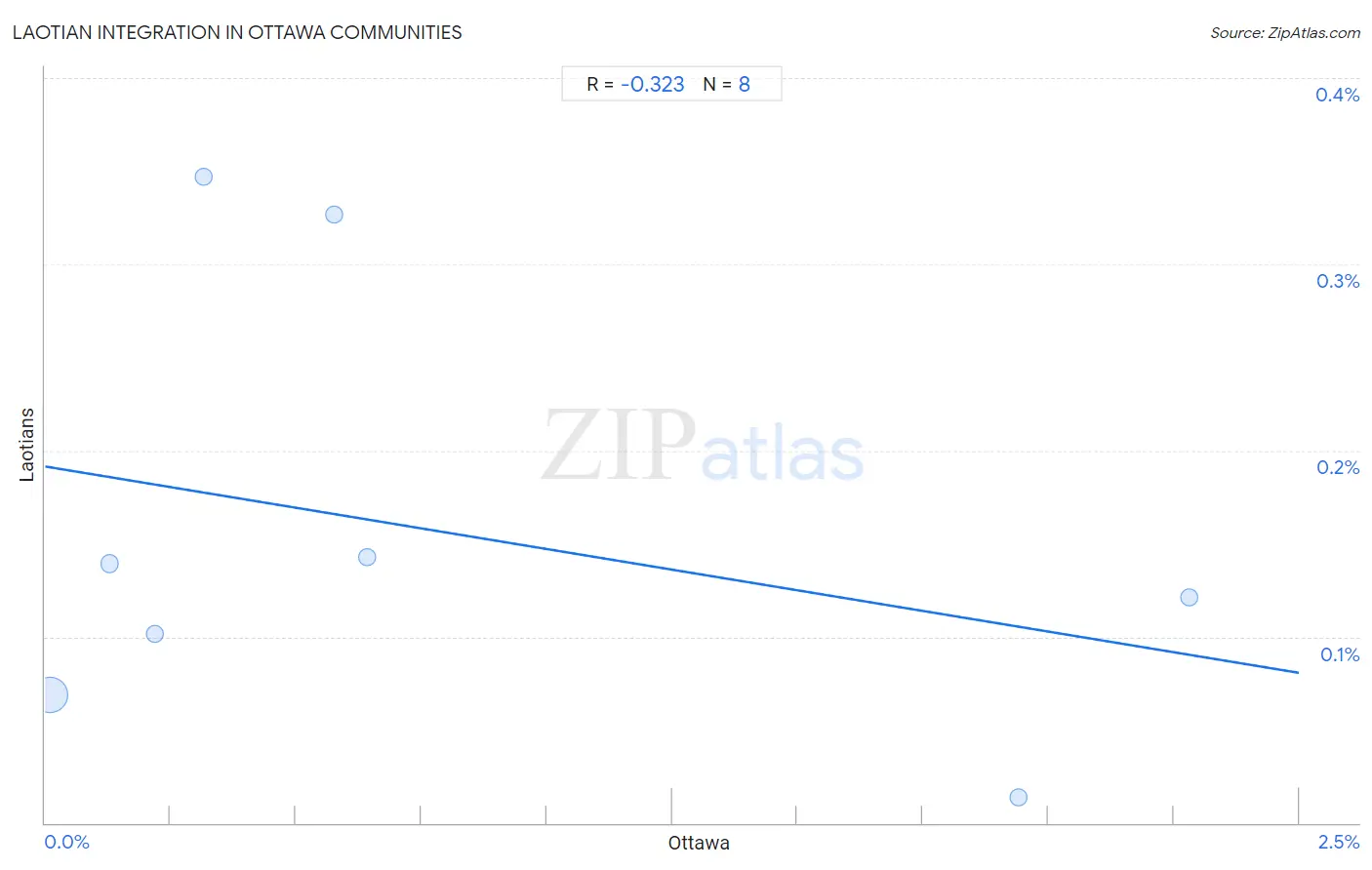
Ottawa vs Laotian Income
When considering income, the most significant differences between Ottawa and Laotian communities in the United States are seen in median household income ($70,984 compared to $94,990, a difference of 33.8%), householder income ages 25 - 44 years ($79,012 compared to $104,993, a difference of 32.9%), and householder income ages 45 - 64 years ($83,953 compared to $111,051, a difference of 32.3%). Conversely, both communities are more comparable in terms of wage/income gap (27.0% compared to 26.4%, a difference of 2.3%), householder income under 25 years ($47,366 compared to $54,369, a difference of 14.8%), and householder income over 65 years ($53,217 compared to $66,306, a difference of 24.6%).

| Income Metric | Ottawa | Laotian |
| Per Capita Income | Tragic $37,101 | Exceptional $47,041 |
| Median Family Income | Tragic $86,380 | Exceptional $112,859 |
| Median Household Income | Tragic $70,984 | Exceptional $94,990 |
| Median Earnings | Tragic $39,721 | Exceptional $50,343 |
| Median Male Earnings | Tragic $46,611 | Exceptional $59,351 |
| Median Female Earnings | Tragic $33,378 | Exceptional $42,133 |
| Householder Age | Under 25 years | Tragic $47,366 | Exceptional $54,369 |
| Householder Age | 25 - 44 years | Tragic $79,012 | Exceptional $104,993 |
| Householder Age | 45 - 64 years | Tragic $83,953 | Exceptional $111,051 |
| Householder Age | Over 65 years | Tragic $53,217 | Exceptional $66,306 |
| Wage/Income Gap | Tragic 27.0% | Poor 26.4% |
Ottawa vs Laotian Poverty
When considering poverty, the most significant differences between Ottawa and Laotian communities in the United States are seen in female poverty among 25-34 year olds (17.1% compared to 12.2%, a difference of 40.3%), child poverty under the age of 5 (20.3% compared to 14.7%, a difference of 38.2%), and child poverty among boys under 16 (19.5% compared to 14.3%, a difference of 36.3%). Conversely, both communities are more comparable in terms of seniors poverty over the age of 65 (10.4% compared to 10.6%, a difference of 1.5%), seniors poverty over the age of 75 (11.4% compared to 12.3%, a difference of 8.3%), and married-couple family poverty (5.2% compared to 4.7%, a difference of 10.2%).
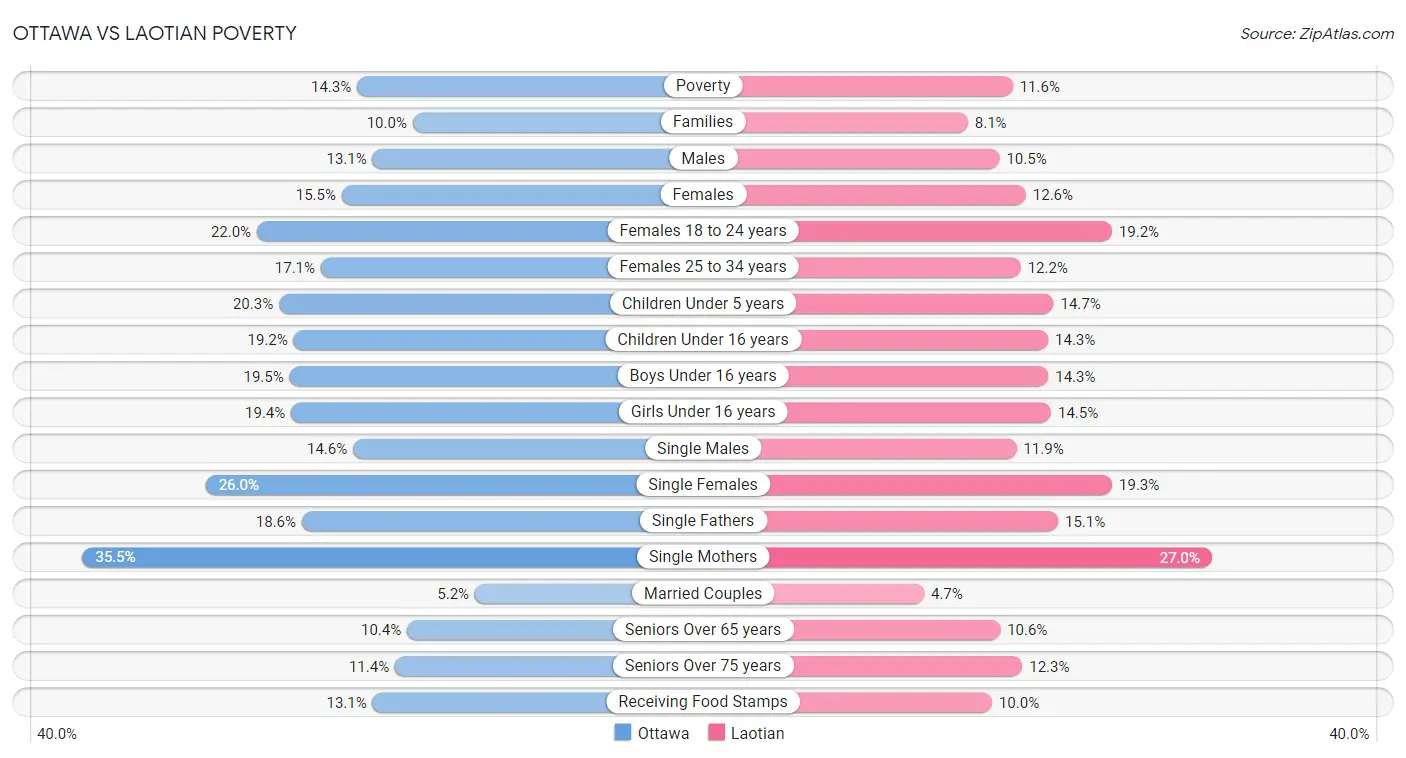
| Poverty Metric | Ottawa | Laotian |
| Poverty | Tragic 14.3% | Exceptional 11.6% |
| Families | Tragic 10.0% | Exceptional 8.1% |
| Males | Tragic 13.1% | Exceptional 10.5% |
| Females | Tragic 15.5% | Exceptional 12.6% |
| Females 18 to 24 years | Tragic 22.0% | Exceptional 19.2% |
| Females 25 to 34 years | Tragic 17.1% | Exceptional 12.2% |
| Children Under 5 years | Tragic 20.3% | Exceptional 14.7% |
| Children Under 16 years | Tragic 19.2% | Exceptional 14.3% |
| Boys Under 16 years | Tragic 19.5% | Exceptional 14.3% |
| Girls Under 16 years | Tragic 19.4% | Exceptional 14.5% |
| Single Males | Tragic 14.6% | Exceptional 11.9% |
| Single Females | Tragic 26.0% | Exceptional 19.3% |
| Single Fathers | Tragic 18.6% | Exceptional 15.1% |
| Single Mothers | Tragic 35.5% | Exceptional 27.0% |
| Married Couples | Average 5.2% | Exceptional 4.7% |
| Seniors Over 65 years | Excellent 10.4% | Good 10.6% |
| Seniors Over 75 years | Exceptional 11.4% | Fair 12.3% |
| Receiving Food Stamps | Tragic 13.1% | Exceptional 10.0% |
Ottawa vs Laotian Unemployment
When considering unemployment, the most significant differences between Ottawa and Laotian communities in the United States are seen in unemployment among women with children under 6 years (9.9% compared to 6.5%, a difference of 51.1%), unemployment among women with children ages 6 to 17 years (10.9% compared to 7.9%, a difference of 37.4%), and unemployment among ages 35 to 44 years (5.6% compared to 4.6%, a difference of 21.8%). Conversely, both communities are more comparable in terms of unemployment among ages 20 to 24 years (10.1% compared to 10.0%, a difference of 0.63%), unemployment among ages 16 to 19 years (16.9% compared to 17.2%, a difference of 1.7%), and unemployment among ages 60 to 64 years (4.9% compared to 4.8%, a difference of 2.4%).
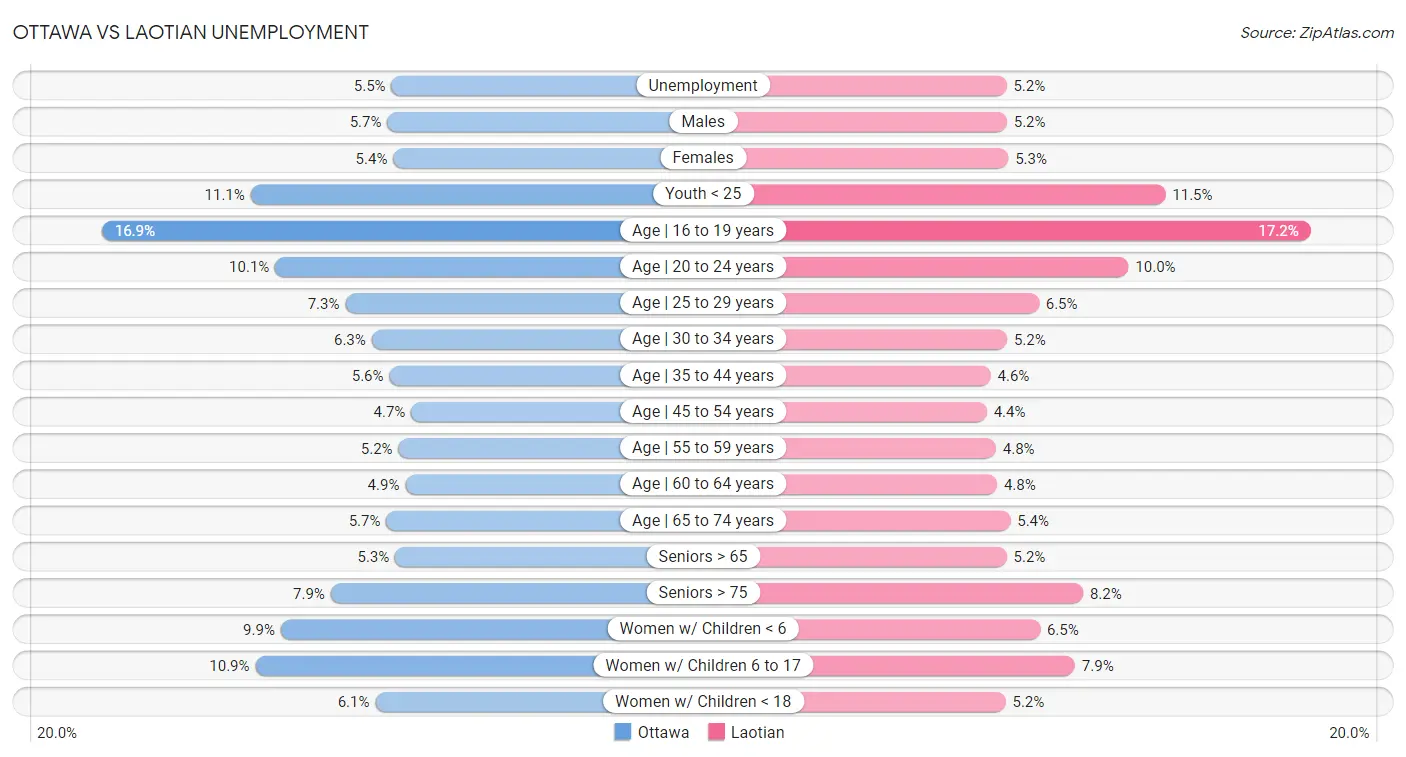
| Unemployment Metric | Ottawa | Laotian |
| Unemployment | Tragic 5.5% | Good 5.2% |
| Males | Tragic 5.7% | Good 5.2% |
| Females | Poor 5.4% | Average 5.3% |
| Youth < 25 | Exceptional 11.1% | Good 11.5% |
| Age | 16 to 19 years | Exceptional 16.9% | Excellent 17.2% |
| Age | 20 to 24 years | Exceptional 10.1% | Exceptional 10.0% |
| Age | 25 to 29 years | Tragic 7.3% | Excellent 6.5% |
| Age | 30 to 34 years | Tragic 6.3% | Exceptional 5.2% |
| Age | 35 to 44 years | Tragic 5.6% | Excellent 4.6% |
| Age | 45 to 54 years | Tragic 4.7% | Excellent 4.4% |
| Age | 55 to 59 years | Tragic 5.2% | Good 4.8% |
| Age | 60 to 64 years | Poor 4.9% | Good 4.8% |
| Age | 65 to 74 years | Tragic 5.7% | Average 5.4% |
| Seniors > 65 | Tragic 5.3% | Poor 5.2% |
| Seniors > 75 | Exceptional 7.9% | Exceptional 8.2% |
| Women w/ Children < 6 | Tragic 9.9% | Exceptional 6.5% |
| Women w/ Children 6 to 17 | Tragic 10.9% | Exceptional 7.9% |
| Women w/ Children < 18 | Tragic 6.1% | Exceptional 5.2% |
Ottawa vs Laotian Labor Participation
When considering labor participation, the most significant differences between Ottawa and Laotian communities in the United States are seen in in labor force | age 16-19 (43.0% compared to 34.9%, a difference of 23.4%), in labor force | age > 16 (62.0% compared to 65.8%, a difference of 6.1%), and in labor force | age 45-54 (79.5% compared to 82.9%, a difference of 4.3%). Conversely, both communities are more comparable in terms of in labor force | age 25-29 (83.0% compared to 84.4%, a difference of 1.7%), in labor force | age 35-44 (82.6% compared to 84.2%, a difference of 2.0%), and in labor force | age 30-34 (82.4% compared to 84.7%, a difference of 2.8%).

| Labor Participation Metric | Ottawa | Laotian |
| In Labor Force | Age > 16 | Tragic 62.0% | Exceptional 65.8% |
| In Labor Force | Age 20-64 | Tragic 76.7% | Average 79.6% |
| In Labor Force | Age 16-19 | Exceptional 43.0% | Tragic 34.9% |
| In Labor Force | Age 20-24 | Exceptional 76.8% | Tragic 74.1% |
| In Labor Force | Age 25-29 | Tragic 83.0% | Poor 84.4% |
| In Labor Force | Age 30-34 | Tragic 82.4% | Average 84.7% |
| In Labor Force | Age 35-44 | Tragic 82.6% | Poor 84.2% |
| In Labor Force | Age 45-54 | Tragic 79.5% | Good 82.9% |
Ottawa vs Laotian Family Structure
When considering family structure, the most significant differences between Ottawa and Laotian communities in the United States are seen in births to unmarried women (36.5% compared to 28.5%, a difference of 28.1%), single father households (2.7% compared to 2.2%, a difference of 19.4%), and divorced or separated (13.2% compared to 11.2%, a difference of 18.1%). Conversely, both communities are more comparable in terms of currently married (46.5% compared to 47.4%, a difference of 2.0%), family households (63.0% compared to 65.8%, a difference of 4.4%), and average family size (3.11 compared to 3.26, a difference of 4.8%).

| Family Structure Metric | Ottawa | Laotian |
| Family Households | Tragic 63.0% | Exceptional 65.8% |
| Family Households with Children | Tragic 26.1% | Exceptional 28.5% |
| Married-couple Households | Poor 45.8% | Exceptional 48.4% |
| Average Family Size | Tragic 3.11 | Excellent 3.26 |
| Single Father Households | Tragic 2.7% | Exceptional 2.2% |
| Single Mother Households | Fair 6.5% | Exceptional 5.8% |
| Currently Married | Average 46.5% | Excellent 47.4% |
| Divorced or Separated | Tragic 13.2% | Exceptional 11.2% |
| Births to Unmarried Women | Tragic 36.5% | Exceptional 28.5% |
Ottawa vs Laotian Vehicle Availability
When considering vehicle availability, the most significant differences between Ottawa and Laotian communities in the United States are seen in no vehicles in household (7.4% compared to 9.1%, a difference of 22.8%), 4 or more vehicles in household (6.6% compared to 7.4%, a difference of 11.4%), and 3 or more vehicles in household (20.1% compared to 21.5%, a difference of 6.8%). Conversely, both communities are more comparable in terms of 2 or more vehicles in household (57.9% compared to 58.6%, a difference of 1.3%), 1 or more vehicles in household (92.7% compared to 91.0%, a difference of 1.8%), and 3 or more vehicles in household (20.1% compared to 21.5%, a difference of 6.8%).

| Vehicle Availability Metric | Ottawa | Laotian |
| No Vehicles Available | Exceptional 7.4% | Exceptional 9.1% |
| 1+ Vehicles Available | Exceptional 92.7% | Exceptional 91.0% |
| 2+ Vehicles Available | Exceptional 57.9% | Exceptional 58.6% |
| 3+ Vehicles Available | Excellent 20.1% | Exceptional 21.5% |
| 4+ Vehicles Available | Excellent 6.6% | Exceptional 7.4% |
Ottawa vs Laotian Education Level
When considering education level, the most significant differences between Ottawa and Laotian communities in the United States are seen in professional degree (3.4% compared to 5.2%, a difference of 52.9%), doctorate degree (1.6% compared to 2.3%, a difference of 45.8%), and master's degree (11.9% compared to 17.0%, a difference of 43.5%). Conversely, both communities are more comparable in terms of 12th grade, no diploma (91.9% compared to 91.3%, a difference of 0.62%), nursery school (98.5% compared to 97.8%, a difference of 0.65%), and kindergarten (98.4% compared to 97.8%, a difference of 0.66%).
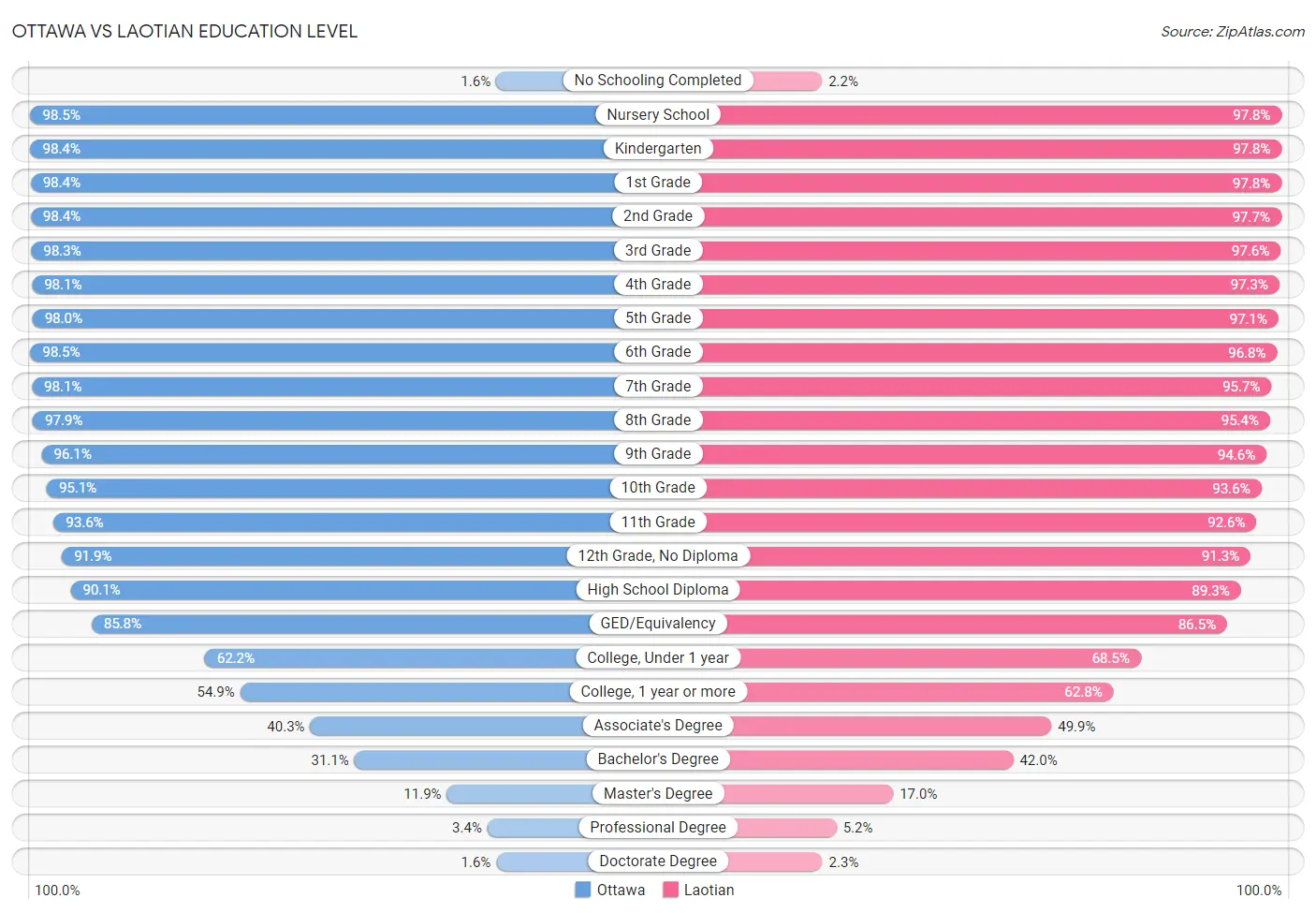
| Education Level Metric | Ottawa | Laotian |
| No Schooling Completed | Exceptional 1.6% | Poor 2.2% |
| Nursery School | Exceptional 98.5% | Tragic 97.8% |
| Kindergarten | Exceptional 98.4% | Poor 97.8% |
| 1st Grade | Exceptional 98.4% | Poor 97.8% |
| 2nd Grade | Exceptional 98.4% | Tragic 97.7% |
| 3rd Grade | Exceptional 98.3% | Tragic 97.6% |
| 4th Grade | Exceptional 98.1% | Tragic 97.3% |
| 5th Grade | Exceptional 98.0% | Poor 97.1% |
| 6th Grade | Exceptional 98.5% | Poor 96.8% |
| 7th Grade | Exceptional 98.1% | Tragic 95.7% |
| 8th Grade | Exceptional 97.9% | Tragic 95.4% |
| 9th Grade | Exceptional 96.1% | Fair 94.6% |
| 10th Grade | Exceptional 95.1% | Fair 93.6% |
| 11th Grade | Exceptional 93.6% | Average 92.6% |
| 12th Grade, No Diploma | Exceptional 91.9% | Good 91.3% |
| High School Diploma | Exceptional 90.1% | Good 89.3% |
| GED/Equivalency | Average 85.8% | Excellent 86.5% |
| College, Under 1 year | Tragic 62.2% | Exceptional 68.5% |
| College, 1 year or more | Tragic 54.9% | Exceptional 62.8% |
| Associate's Degree | Tragic 40.3% | Exceptional 49.9% |
| Bachelor's Degree | Tragic 31.1% | Exceptional 42.0% |
| Master's Degree | Tragic 11.9% | Exceptional 17.0% |
| Professional Degree | Tragic 3.4% | Exceptional 5.2% |
| Doctorate Degree | Tragic 1.6% | Exceptional 2.3% |
Ottawa vs Laotian Disability
When considering disability, the most significant differences between Ottawa and Laotian communities in the United States are seen in disability age 35 to 64 (14.6% compared to 10.1%, a difference of 44.6%), disability age under 5 (1.7% compared to 1.2%, a difference of 39.6%), and disability age 18 to 34 (8.6% compared to 6.2%, a difference of 37.9%). Conversely, both communities are more comparable in terms of disability age over 75 (47.6% compared to 47.9%, a difference of 0.62%), cognitive disability (18.2% compared to 17.3%, a difference of 5.2%), and self-care disability (2.7% compared to 2.4%, a difference of 11.5%).
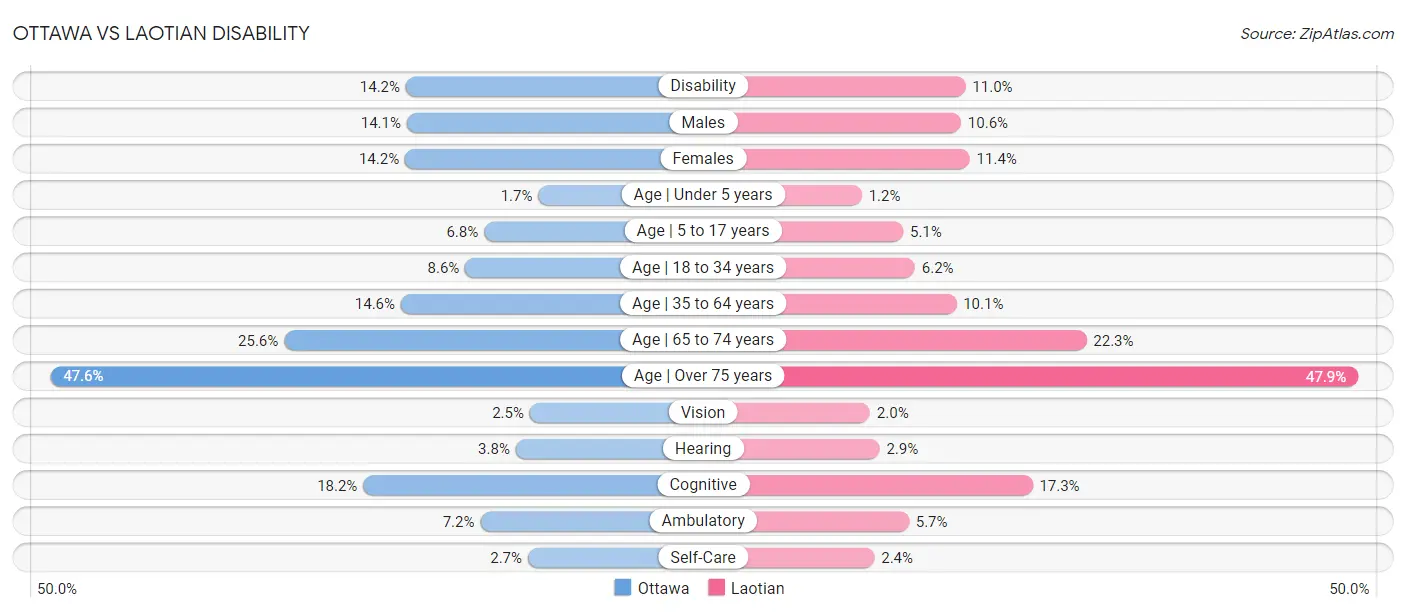
| Disability Metric | Ottawa | Laotian |
| Disability | Tragic 14.2% | Exceptional 11.0% |
| Males | Tragic 14.1% | Exceptional 10.6% |
| Females | Tragic 14.2% | Exceptional 11.4% |
| Age | Under 5 years | Tragic 1.7% | Good 1.2% |
| Age | 5 to 17 years | Tragic 6.8% | Exceptional 5.1% |
| Age | 18 to 34 years | Tragic 8.6% | Exceptional 6.2% |
| Age | 35 to 64 years | Tragic 14.6% | Exceptional 10.1% |
| Age | 65 to 74 years | Tragic 25.6% | Exceptional 22.3% |
| Age | Over 75 years | Fair 47.6% | Poor 47.9% |
| Vision | Tragic 2.5% | Exceptional 2.0% |
| Hearing | Tragic 3.8% | Excellent 2.9% |
| Cognitive | Tragic 18.2% | Average 17.3% |
| Ambulatory | Tragic 7.2% | Exceptional 5.7% |
| Self-Care | Tragic 2.7% | Excellent 2.4% |